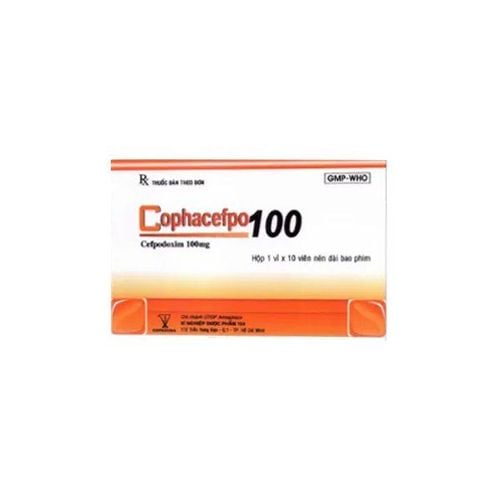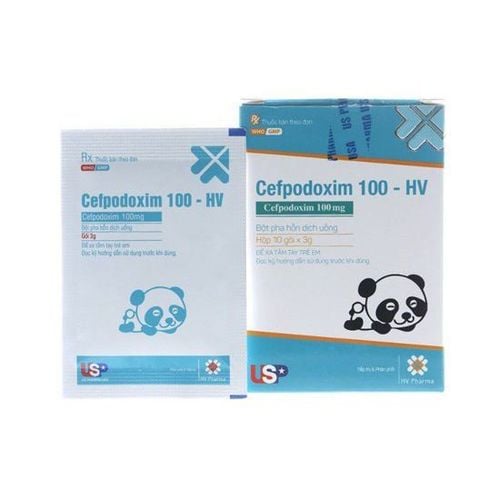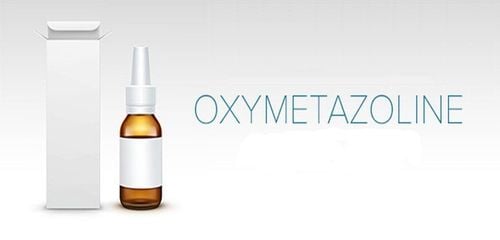This is an automatically translated article.
Abvaceff 200 mg medicine is used to treat mild to moderate diseases of the lower respiratory tract, mild and moderate infections of the upper respiratory tract. To better understand what is Abvaceff 200mg? What is the correct way to drink? What are the points to pay attention to when using? Please read the article below.
1. What is Abvaceff 200 mg?
Abvaceff has the main ingredient cefpodoxime, belongs to the group of Cephalosporin antibiotics, is made in the form of tablets with a strength of 200 mg for adults and a powder for oral suspension of 200 mg for children. The drug is manufactured by US Pharma USA Co., Ltd.
Ingredients in 1 pack of Abvaceff 200 mg for children include:
Cefpodoxim (As active ingredient cefpodoxime proxetil): 200mg Excipients: Anhydrous Dextrose, RE Sugar, Kollidon CL-M, Aspartam, Xanthan gum, PVP K30, Aerosil (Colloidal silicon dioxide), Magnesium Stearate, Orange smell Abvaceff medicine 200 mg is prescribed by doctors in the following cases:
Upper respiratory tract infections including sinusitis, acute otitis media, tonsillitis and pharyngitis . Patients with community-acquired acute pneumonia, mild and moderate urinary tract infections, treatment of acute gonorrhea,... Acute gonococcal infection without complications. Uncomplicated urinary tract infection. Skin and skin structure infections.
2. What are the uses of Abvaceff 200 mg?
2.1. Pharmacodynamics Cefpodoxime is an antibiotic belonging to the 3rd generation Cephalosporin group. In developed countries with a low rate of antibiotic resistance, Cefpodoxime has a very high resistance to attack by beta-lactamase bacteria, caused by bacteria. Gram negative and Gram positive produce.
In principle, Cefpodoxime has high activity against Gram-positive cocci such as pneumococci (Streptococcus pneumoniae), streptococcus (Streptococcus) groups A, B, C, G and with staphylococcus S. Epidermidis has or not produce beta - lactamase, Staphylococcus aureus. However, the drug is not effective against isoxazolyl-penicillin-resistant staphylococci due to a change in the penicillin binding protein (methicillin-resistant Staphylococcus aureus MRSA). This type of MRSA antibiotic resistance is developing with increasing numbers in Vietnam.
Cefpodoxime is also effective against Gram-positive and Gram-negative bacilli, and Gram-negative cocci. The drug is active against important pathogenic Gram-negative bacteria such as Klebsiella, E. coli, Proteus mirabilis and Citrobacter.
However, in Vietnam, due to the arbitrary use of antibiotics, these bacteria are also resistant to 3rd generation cephalosporins. This issue should be noted because it is a risk of treatment failure.
In contrast to other oral cephalosporins, cefpodoxime is stable to beta-lactamases produced by Haemophilus influenzae, Moraxella catarrhalis and Neisseria. However, this observation has not been systematically monitored in Vietnam and to what extent the potency of cefpodoxime is superior to that of other oral cephalosporins is unknown.
Cefpodoxime has little effect on Proteus vulgaris, Enterobacter, Serratia marcescens and Clostridium perfringens. These bacteria are sometimes completely resistant.
Methicillin-resistant Staphylococcus aureus, Staphylococcus saprophyticus, Enterococcus, Pseudomonas aeruginosa, Pseudomonas spp., Clostridium difficile, Bacteroides fragilis, Listeria, Mycoplasma pneumoniae, Chlamydia and Legionella pneumophila are usually completely resistant to cephalosporins.
2.2. Pharmacokinetics Cefpodoxime is the oral form of cefpodoxime proxetil (the ester of cefpodoxime). Cefpodoxime proxetil has little antibacterial activity when it is not hydrolyzed to cefpodoxime in the body. Cefpodoxime proxetil is absorbed from the gastrointestinal tract and is metabolised by nonspecific esterases, possibly in the intestinal wall, to the active metabolite cefpodoxime.
The bioavailability of cefpodoxime is approximately 50% in uneaten subjects. This bioavailability is increased when cefpodoxime is administered with food. The serum half-life of cefpodoxime is 2.1 to 2.8 hours in patients with normal renal function. The serum half-life is increased to 3.5 - 9.8 hours in subjects with renal insufficiency.
After oral administration of a single dose of cefpodoxime, in healthy adults with normal renal function, peak plasma concentrations are reached within 2 - 3 hours and have an average value of 1.4 micrograms/ml, 2.3 microgram/ml, 3.9 microgram/ml for doses of 100mg, 200mg, 400mg.
Approximately 20 - 30% of cefpodoxime is bound to plasma proteins. The drug is eliminated unchanged by glomerular filtration and tubular secretion. Approximately 29-38% of the dose is eliminated within 12 hours in adults with normal renal function. No biotransformation occurs in the kidneys and liver. The drug is eliminated to a certain extent during hemodialysis.
3. Contraindications of Abvaceff 200 mg
Patients who are allergic to any of the ingredients or excipients of Abvaceff 200 mg or to Cephalosporins who have disorders of porphyrin metabolism.
4. Undesirable effects when using Abvaceff 200 mg
Common:
Gastrointestinal: Nausea, vomiting, abdominal pain, diarrhea. General: Headache. Uncommon:
Allergic bodily reactions: Serum sickness-like reactions with fever, rash, arthralgia and anaphylactic reactions. Skin: Erythema multiforme. Liver: hepatitis, liver enzyme disorders and transient cholestatic jaundice. Rare:
Blood: blood disorders, eosinophilia. Kidneys: Interstitial nephritis is reversible. Central nervous system: Hyperactivity, agitation, difficulty sleeping, confusion, hypertonia and dizziness.
5. Abvaceff 200 mg drug interactions
H2 antihistamines and antacids reduce the bioavailability of cefpodoxime. Probenecid reduces the excretion of cephalosporins. Cephalosporins potentiate the anticoagulant effect of coumarin and decrease the contraceptive effect of oestrogen. Oral Anticoagulants: Concomitant administration of cefpodoxime with warfarin may further potentiate the anticoagulant effect. There have been numerous reports of increased anticoagulant activity in patients receiving antibacterial agents, including cephalosporins, who required frequent INR monitoring during and immediately after administration of cefpodoxime with an anticoagulant used. oral route. Studies have shown that cefpodoxime bioavailability is reduced by approximately 30% when cefpodoxime is co-administered with drugs that neutralize gastric pH or inhibit acid secretion. Therefore, medications such as mineral antacids and H2 blockers such as ranitidine should be taken 2 to 3 hours after cefpodoxime. Alteration of laboratory values: Cephalosporins cause a positive direct Coomb test.
6. Notes when using Abvaceff 200 mg
Cefpodoxime is not a preferred antibiotic for the treatment of staphylococcal pneumonia and should not be used in the treatment of atypical pneumonia caused by bacteria such as Legionella, Mycoplasma and Chlamydia. Cefpodoxime is not recommended for the treatment of pneumonia caused by S. Pneumoniae. As with all beta-lactam antibacterials, serious and sometimes fatal hypersensitivity reactions have been reported. In the event of a severe hypersensitivity reaction, treatment with Abvaceff 200 mg should be discontinued immediately and appropriate measures taken. Before initiating therapy, the patient's history of serious hypersensitivity reactions to cefpodoxime, other cephalosporins or to any beta-lactam antibacterial agent should be ascertained. Use with caution if cefpodoxime is administered to patients with a history of non-serious hypersensitivity to other beta-lactams. In case of severe renal impairment, dose reduction is dependent on creatinine clearance. Antibacterial-associated colitis and pseudomembranous colitis have been reported with nearly all antibacterial agents, including cefpodoxime, and can range in severity from mild to life-threatening. . Therefore, it is important to consider the diagnosis in patients who present with diarrhea during or after administration of Abvaceff 200 mg. Discontinue treatment with Abvaceff and consider the need for Clostridium difficile therapy. Drugs that inhibit intestinal motility should not be used. Abvaceff 200 mg should be used with caution in patients with a history of gastrointestinal disease, especially colitis. As with all beta-lactam antibiotics, leukopenia and rarely agranulocytosis may develop especially during prolonged therapy. For treatment lasting more than 10 days, blood cell counts should be monitored and treatment discontinued if leukopenia occurs. Cephalosporins can be absorbed onto the surface of red blood cell membranes and react with antibodies directed against the drug. This can cause a positive Coombs reaction and in very rare cases hemolytic anemia. Cross-reactivity is possible with penicillin for this reaction. Changes in renal function have been observed with cephalosporin antibiotics, especially when co-administered with potentially nephrotoxic drugs such as aminoglycosides or diuretics. In such cases, close monitoring of renal function is required. As with other antibiotics, prolonged use of Abvaceff 200 mg may lead to overgrowth of non-susceptible organisms (Clostridium difficile and Candida), which in each individual case may require treatment. stop treatment. The product contains lactose, so it should not be used for Lapp - lactase deficiency, galactose intolerance, glucose - galactose malabsorption. Because the drug can cause dizziness, it should be used with caution when driving or operating machinery. Cefpodoxime is excreted in human milk in low concentrations. Although only at a low concentration, there are still 3 problems that will occur for babies fed formula containing cefpodoxime: Disorders of intestinal flora, direct effects on the child's body, and errors in results. Bacterial culture, if you have to do antibiotics when there is a fever.
7. How to use Abvaceff 200 mg effectively?
How to use:
Should take Abvaceff 200 with at least 30 - 50ml of filtered water, preferably boiled and cooled water. Avoid using the drug with carbonated water, milk, alcohol, beer. It is best to take the drug after main meals. Do not chew or crush the medicine to avoid losing its effectiveness. Dosage in adults and adolescents with normal renal function:
Acute bacterial sinusitis: 200 mg twice daily. Acute exacerbation of chronic bronchitis: 200 mg twice daily. Community-acquired bacterial pneumonia: 200 mg twice daily. Uncomplicated acute gonococcal infection: 200 mg single dose. Uncomplicated urinary tract infections: 100mg every 12 hours for 7 days. Skin and skin structure infections: 400 mg every 12 hours for 7-14 days. Dosage in children:
Acute otitis media: 10 mg/kg/day (maximum 400 mg/day in 2 divided doses) for 10 days. Pharyngitis and tonsillitis: 10 mg/kg/day (maximum 200 mg/day in 2 divided doses) for 10 days. Cefpodoxime should be administered with food. In patients with renal impairment (creatinine clearance less than 30 ml/min), the dosing interval should be increased to 24 hours Acute compartmentitis (mild to moderate acute cheek cavity inflammation): 5 mg/kg (up to 200 mg): ) every 12 hours, for 12 days. Uncomplicated gonorrhea (8 years old, weight > 45 kg): 1 single dose of 400 mg, combined with 1 antibiotic effective for Chlamydia infection. Community-acquired pneumonia, acute exacerbation of chronic bronchitis: 200 mg every 12 hours, for 14 days and 10 days respectively. Dermatitis and skin structure: 400 mg every 12 hours, for 7-14 days. Uncomplicated urinary tract infections: 100mg every 12 hours for 7 days. Dosage in patients with renal impairment:
No dosage adjustment of cefpodoxime is necessary if the creatinine clearance is greater than 40 ml/min. Overdose:
Manifestations of overdose with cefpodoxime proxetil have not been reported. Symptoms of overdose may include nausea, vomiting, epigastric pain, and diarrhea. In the event of a severe toxic reaction from an overdose, hemodialysis or peritoneal dialysis may help remove cefpodoxime from the body, especially when renal function is impaired.
8. Note, caution when using Abvaceff 200mg
Keep out of reach of CHILDREN. Avoid getting the medicine in your eyes. Consult your doctor before use. Read the instructions for use carefully and make sure Abvaceff 200mg is still within the expiry date. Use of Abvaceff 200 mg in pregnant or nursing women: Consider and consult your doctor or pharmacist before taking this medicine. Even tested drugs still have risks when used. Using Abvaceff 200mg with drivers and operating machines: The specific effect of the drug on these subjects is unknown. Caution should be exercised when this drug is used in people driving and operating machinery.
9. How to store Abvaceff 200mg
Store Abvaceff 200mg in a cool, dry place. The temperature should not exceed 30°C. Avoid direct sun exposure. Keep out of reach of children and pets. In summary, Abvaceff has the main ingredient cefpodoxime, a member of the Cephalosporin antibiotic group, used to treat mild to moderate diseases of the lower respiratory tract, mild and moderate infections of the upper respiratory tract. Taking the medicine exactly as prescribed by the doctor will help the patient use the medicine safely and effectively.
Please dial HOTLINE for more information or register for an appointment HERE. Download MyVinmec app to make appointments faster and to manage your bookings easily.













